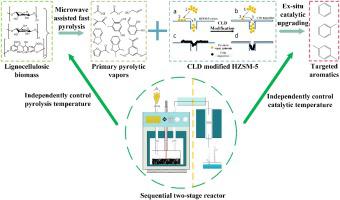当前位置:
X-MOL 学术
›
J. Anal. Appl. Pyrol.
›
论文详情
Our official English website, www.x-mol.net, welcomes your
feedback! (Note: you will need to create a separate account there.)
Ex-situ catalytic upgrading of vapors from microwave-assisted pyrolysis of bamboo with chemical liquid deposition modified HZSM-5 to enhance aromatics production
Journal of Analytical and Applied Pyrolysis ( IF 5.8 ) Pub Date : 2020-08-01 , DOI: 10.1016/j.jaap.2020.104857 Haoran Du , Zhaoping Zhong , Bo Zhang , Kun Shi , Zhaoying Li
Journal of Analytical and Applied Pyrolysis ( IF 5.8 ) Pub Date : 2020-08-01 , DOI: 10.1016/j.jaap.2020.104857 Haoran Du , Zhaoping Zhong , Bo Zhang , Kun Shi , Zhaoying Li

|
Abstract The ex-situ catalytic upgrading of vapors from the microwave-assisted pyrolysis of bamboo sawdust for aromatics-rich bio-oil production was investigated. It was found that the sequential two-stage reactor, with microwave-assisted fixed bed and independent vertical reforming furnace, could separately optimize both the pyrolysis and catalytic upgrading processes. Besides, for purpose of decreasing coke generation and enhancing aromatics yield during the catalytic fast pyrolysis (CFP) of bamboo, chemical liquid deposition (CLD) was used to modify HZSM-5, which played a significant role in reducing external acid sites and narrowing the pore-opening size of catalyst. Experimental results illustrated that the yield of pyrolyzed oil initially increased, and then decreased, with increasing pyrolysis temperature, achieving its maximum at 550 ℃. In addition, the effect of different CLD modifying conditions (modifier type, deposited amount, and deposition time) on aromatics proportion of the obtained bio-oil was further explored. The consequences presented the TiO2-modified HZSM-5 (deposited amount, 4%; deposition time, 4 h) provided the maximal yield of BTX (benzene, toluene and xylene, 23.58%) compared to the original HZSM-5 (BTX: 16.96%), and the coke generation clearly declined. Simultaneously, the catalytic temperature and catalyst to biomass mass ratio (C/B) in ex-situ upgrading process were also investigated, and it was found that the concentration of BTX was maximized at catalytic temperature of 500 ℃, and C/B = 1.
中文翻译:

用化学液相沉积改性 HZSM-5 对微波辅助竹子热解产生的蒸汽进行异位催化升级以提高芳烃产量
摘要 研究了用于生产富含芳烃的生物油的竹木屑微波辅助热解蒸汽的异位催化升级。结果表明,具有微波辅助固定床和独立立式重整炉的顺序两级反应器可以分别优化热解和催化升级过程。此外,为了减少竹子催化快速热解 (CFP) 过程中的焦炭生成和提高芳烃收率,采用化学液相沉积 (CLD) 对 HZSM-5 进行改性,在减少外部酸位和缩小竹子的催化剂的开孔尺寸。实验结果表明,随着热解温度的升高,热解油的产率先增加后降低,在550 ℃达到最大值。此外,进一步探讨了不同CLD改性条件(改性剂类型、沉积量和沉积时间)对所得生物油芳烃比例的影响。结果表明,与原始 HZSM-5(BTX:16.96)相比,TiO2 改性的 HZSM-5(沉积量,4%;沉积时间,4 小时)提供了最大的 BTX(苯、甲苯和二甲苯,23.58%)产率%),焦炭生成量明显下降。同时,还考察了异位改质过程中的催化温度和催化剂与生物质质量比(C/B),发现催化温度为500℃时BTX的浓度最大,C/B=1 . 和沉积时间)对获得的生物油的芳烃比例进行了进一步探索。结果表明,与原始 HZSM-5(BTX:16.96)相比,TiO2 改性的 HZSM-5(沉积量,4%;沉积时间,4 小时)提供了最大的 BTX(苯、甲苯和二甲苯,23.58%)产率%),焦炭生成量明显下降。同时,还考察了异位改质过程中的催化温度和催化剂与生物质质量比(C/B),发现催化温度为500℃时BTX的浓度最大,C/B=1 . 和沉积时间)对获得的生物油的芳烃比例进行了进一步探索。结果表明,与原始 HZSM-5(BTX:16.96)相比,TiO2 改性的 HZSM-5(沉积量,4%;沉积时间,4 小时)提供了最大的 BTX(苯、甲苯和二甲苯,23.58%)产率%),焦炭生成量明显下降。同时,还考察了异位改质过程中的催化温度和催化剂与生物质质量比(C/B),发现催化温度为500℃时BTX的浓度最大,C/B=1 . 焦炭产量明显下降。同时,还考察了异位改质过程中的催化温度和催化剂与生物质质量比(C/B),发现催化温度为500℃时BTX的浓度最大,C/B=1 . 焦炭产量明显下降。同时,还考察了异位改质过程中的催化温度和催化剂与生物质质量比(C/B),发现催化温度为500℃时BTX的浓度最大,C/B=1 .
更新日期:2020-08-01
中文翻译:

用化学液相沉积改性 HZSM-5 对微波辅助竹子热解产生的蒸汽进行异位催化升级以提高芳烃产量
摘要 研究了用于生产富含芳烃的生物油的竹木屑微波辅助热解蒸汽的异位催化升级。结果表明,具有微波辅助固定床和独立立式重整炉的顺序两级反应器可以分别优化热解和催化升级过程。此外,为了减少竹子催化快速热解 (CFP) 过程中的焦炭生成和提高芳烃收率,采用化学液相沉积 (CLD) 对 HZSM-5 进行改性,在减少外部酸位和缩小竹子的催化剂的开孔尺寸。实验结果表明,随着热解温度的升高,热解油的产率先增加后降低,在550 ℃达到最大值。此外,进一步探讨了不同CLD改性条件(改性剂类型、沉积量和沉积时间)对所得生物油芳烃比例的影响。结果表明,与原始 HZSM-5(BTX:16.96)相比,TiO2 改性的 HZSM-5(沉积量,4%;沉积时间,4 小时)提供了最大的 BTX(苯、甲苯和二甲苯,23.58%)产率%),焦炭生成量明显下降。同时,还考察了异位改质过程中的催化温度和催化剂与生物质质量比(C/B),发现催化温度为500℃时BTX的浓度最大,C/B=1 . 和沉积时间)对获得的生物油的芳烃比例进行了进一步探索。结果表明,与原始 HZSM-5(BTX:16.96)相比,TiO2 改性的 HZSM-5(沉积量,4%;沉积时间,4 小时)提供了最大的 BTX(苯、甲苯和二甲苯,23.58%)产率%),焦炭生成量明显下降。同时,还考察了异位改质过程中的催化温度和催化剂与生物质质量比(C/B),发现催化温度为500℃时BTX的浓度最大,C/B=1 . 和沉积时间)对获得的生物油的芳烃比例进行了进一步探索。结果表明,与原始 HZSM-5(BTX:16.96)相比,TiO2 改性的 HZSM-5(沉积量,4%;沉积时间,4 小时)提供了最大的 BTX(苯、甲苯和二甲苯,23.58%)产率%),焦炭生成量明显下降。同时,还考察了异位改质过程中的催化温度和催化剂与生物质质量比(C/B),发现催化温度为500℃时BTX的浓度最大,C/B=1 . 焦炭产量明显下降。同时,还考察了异位改质过程中的催化温度和催化剂与生物质质量比(C/B),发现催化温度为500℃时BTX的浓度最大,C/B=1 . 焦炭产量明显下降。同时,还考察了异位改质过程中的催化温度和催化剂与生物质质量比(C/B),发现催化温度为500℃时BTX的浓度最大,C/B=1 .











































 京公网安备 11010802027423号
京公网安备 11010802027423号